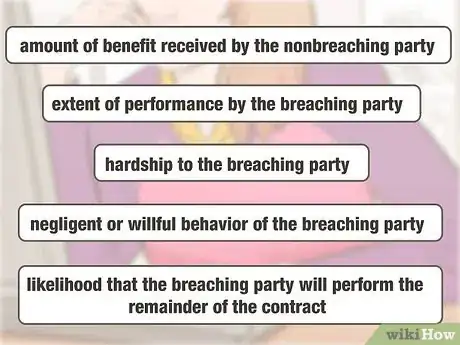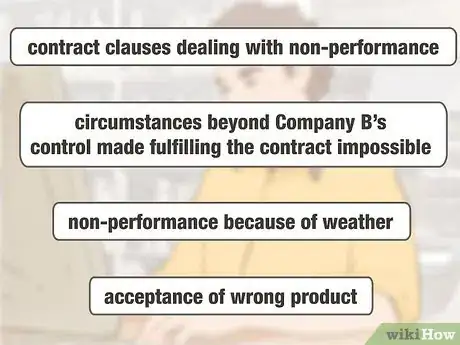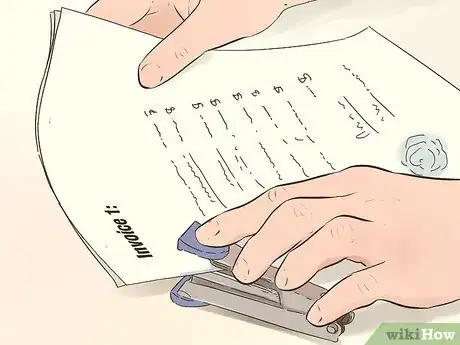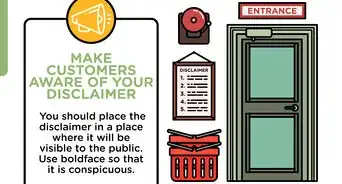This article was co-authored by Clinton M. Sandvick, JD, PhD. Clinton M. Sandvick worked as a civil litigator in California for over 7 years. He received his JD from the University of Wisconsin-Madison in 1998 and his PhD in American History from the University of Oregon in 2013.
There are 8 references cited in this article, which can be found at the bottom of the page.
This article has been viewed 82,677 times.
A contract is breached when one party doesn't live up to the promises he made in the agreement. The breach can occur when he either fails to provide goods or perform a service, or does something that harms you or your business. If this happens, you will need to be able to calculate how much you lost in time, money, and reputation before you can recover money damages in a negotiation or in court.
Steps
Defining the Breach of Contract
-
1Outline the scope of the the contract. Many contract disputes do not rise to the level of a breach. There are several factors the court will consider when determining whether or not you are entitled to recover damages.[1]
-
2Examine the contract and define the role of each party. There must be a valid contract that clearly states the role of each party. It can be as simple as "Company B will deliver 500 blue widgets to Company A for $10 each. Delivery in 30 days," or a complicated operating agreement that mixes goods and services.[2]
- In this case, Company B was responsible for delivering the goods as ordered and on time. Company A was responsible for paying for the goods.
Advertisement -
3Define the breach and determine the materiality of the breach. You must be able to pinpoint where the other party failed to honor the contract. The widgets could have arrived in the wrong color or in 45 days instead of 30. The vendor could have sent you a bill for $11 each instead of $10. These conditions may be considered to be material breaches of the contract.
- A minor or non-material breach would be something that may have annoyed you, such as the parts being a different shade of blue than you expected or arrived a day late, but didn't cause you to lose business or have to spend more to make up for the problem.
- All of these conditions are contract disputes. In order for the wrong color, the delay, or the price difference to be a material, or significant, breach of the contract, you must show that you suffered a loss because of it.[3]
-
4Determine the mitigating factors. For example, if you are still able to sell the wrong color widgets for the same price, you have mitigated, or lessened your loss. Conversely, if the delay caused you to miss a delivery date or pay more for replacement parts to complete your project, then this is a material damage, or harm, that you can put a dollar value on. The price discrepancy can be considered damages if the vendor does not immediately issue a refund or give you a credit to your account.[4]
-
5Anticipate the other party's defenses. There are a few common defenses to a breach of contract. You need to anticipate them and prepare your own argument against the defenses.
- The first defense is that the contract may include specific clauses dealing with non-performance. If the language limits your damages, strongly consider consulting with an attorney to see if the clauses are enforceable.
- Another common defense is that circumstances beyond Company B's control made fulfilling the contract impossible. For example, the only company that makes blue widgets burns down and red widgets were the only ones available. If Company B reasonably believed that red widgets would suffice, they may claim impossibility as a defense.
- Non-performance because of weather is a common and valid defense for delays in shipping and delivery. Typically, expected weather such as normal rain and snow will not be a valid excuse. It can be assumed that Company B should have factored normal weather into the delivery schedule. However, extraordinary weather such as blizzards, floods, and tornadoes may be seen as a valid defense to breach of the contract.[5]
- Acceptance may also be used as a defense to your claim of breach of contract. If you unpacked the incorrect widgets and offered them to your customers before complaining of the breach, then Company B may be able to claim that you accepted the order and released them from liability.
Calculating Your Damages
-
1Gather your documentation. To calculate your damages, you must be able to document the terms of the contract, what went wrong in the contract, and how you lost time or money because of the problem.
- Documents might include invoices for other materials that you had to purchase to make up for the shortfall or proof that you had to pay overtime or another contractor to fix the situation.
-
2Separate the damages into tangible and intangible. Tangible damages are goods or services you had to pay money for to make up for the breach of contract. These are your most important damages and the hardest for the other side to refute. You can prove them with invoices and receipts to show the amount of money you had to spend to make things right.
- Examples of tangible damages include, if a mechanic failed to fix your car and you had to pay another shop to make the repairs, the cost of the second repair is your damages. If you had to buy widgets at a higher price from another supplier because your shipment was late, the difference in price could be tangible damages. If a late delivery required you to pay overtime to your employees to fulfill orders, the excess wages can be claimed as tangible damages.
- Intangible damages are harder to classify, but can be claimed if you can prove them. This includes loss of reputation or loss of business opportunities. The easiest type of intangible damage to prove is the loss of a customer or contract. Still, these damages are speculative and can be much harder to prove. Consider consulting with a business accountant or business attorney to discuss how to quantify intangible damages or you may not receive compensation.
-
3Classify your damages into the legal categories. The law recognizes three broad categories of damages. In your cause of action for breach of contract, you will be claiming either expectation, reliance, or restitution.[6]
- When you entered into the contract, you expected a certain result. You expected Company B to deliver the goods you ordered in the time promised by the vendor. If you bought 500 widgets at $10 each and expected to sell them at $20 each, you expected to make $5,000. Your documents will bolster your claim for lost sales and profits.
- You may have taken certain actions in reliance on the contract. If you incurred costs based on the promise that Company B would deliver your goods, such as displays or advertising, you may be able to claim the cost of your actions as damages against Company B.
- Restitution is a return of money you paid to Company B or others because of Company B's failure to perform. Direct restitution would include return of deposits or price differences that were not approved. Indirect restitution is the cost of replacement goods, excess wages, or hiring another contractor.
-
4Submit your losses. Once your calculations are complete, you can submit your losses to an attorney for assistance with a lawsuit or directly to the other party. The summary you wrote earlier, be it notes, a memo, or a spreadsheet, will be the basis of your negotiations.
- If the breach of contract was easy to define and quantify, you can try to settle it yourself via a demand letter[7] or use your research as the basis of a lawsuit in small claims court.[8] If your dispute is for more than the small claims limit for your state, typically $3,000 to $10,000, you should strongly consider consulting with an attorney to pursue your claim in district court.
References
- ↑ http://jec.unm.edu/education/online-training/contract-law-tutorial/breach-of-contract
- ↑ https://www.law.cornell.edu/wex/contract
- ↑ http://www.berkowitzkleinllp.com/2013/the-differences-between-material-and-non-material-breach-of-contract/
- ↑ https://www.law.cornell.edu/wex/duty_to_mitigate
- ↑ http://jec.unm.edu/education/online-training/contract-law-tutorial/defenses-to-breach
- ↑ http://www.law.nyu.edu/sites/default/files/ECM_PRO_063763.pdf
- ↑ http://www.peoples-law.org/example-good-demand-letter-0
- ↑ http://www.nolo.com/legal-encyclopedia/small-claims-suits-how-much-30031.html






































































